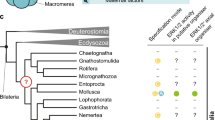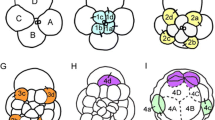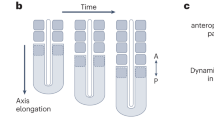Abstract
The embryonic origin of metameric segmentation was examined in the oligochaete Tubifex using lineage tracers. Segments in Tubifex embryos arise from five bilateral pairs of longitudinal coherent columns (bandlets) of primary blast cells which are generated by five bilateral pairs of embryonic stem cells called teloblasts (M, N, O, P and Q). As development proceeds, an initially linear array of blast cells in each ectodermal bandlet gradually changes its shape in a lineage-specific manner. These morphogenetic changes result in the formation of distinct cell clumps, which are separated from the bandlet to serve as segmental elements (SEs). SEs in the N and Q lineages are each comprised of clones of two consecutive primary blast cells. In contrast, in the O and P lineages, individual blast cell clones are distributed across SE boundaries; each SE is a mixture of a part of the preceding anterior clone and a part of the next posterior clone. Morphogenetic events, including segmentation, in an ectodermal bandlet proceed normally in the absence of neighboring ectodermal bandlets. Without the underlying mesoderm, separated SEs fail to space themselves at regular intervals along the anteroposterior axis. It is suggested that ectodermal segmentation in Tubifex consists of two stages; autonomous morphogenesis of each bandlet leading to generation of SEs, and the ensuing mesoderm-dependent alignment of separated SEs. In contrast, metameric segmentation in the mesoderm (M lineage) is a one-step process in that it arises from an initially simple organization (i.e. a linear series) of primary m-blast cells, which individually serve as a founder cell of each segment. The boundary between mesodermal segments is determined autonomously. The results of a set of cell ablation and transplantation experiments, using alkaline phosphatase activity as a biochemical marker for segments VII and VIII suggest that segmental identities in primary m-blast cells are determined according to the genealogical position in the M lineage and that the M teloblast possesses a developmental program through which the sequence of blast cell identities is determined.
Similar content being viewed by others
References
Arai, A., A. Nakamoto & T. Shimizu, 2001. Specification of cell fates of ectoteloblast lineages in embryos of the oligochaete annelid Tubifex: involvement of novel cell–cell interactions. Development 128: 1211–1219.
Blair, S. S., 1982. Interactions between mesoderm and ectoderm in segment formation in the embryo of a glossiphoniid leech. Dev. Biol. 89: 389–396.
Brusca, R. C & G. J. Brusca, 1990. Invertebrates. Sinauer, Sunderland.
Devries, J., 1973a. La formation et la destinée des feuillets embryonnaires chez le lombricien Eisenia foetida (Annélide Oligochète). Arch. Anat. Microsc. 62: 15–38.
Devries, J., 1973b. Détermination précoce du développement embryonnaire chez le lombricien Eisenia foetida. Bull. Soc. Zool. Fr. 98: 405–417.
Fernandez, F. & N. Olea, 1982. Embryonic development of glossiphoniid leeches. In Harrison, F. W. & R. R. Cowden (eds), Developmental Biology of Freshwater Invertebrates. Alan R. Liss, New York: 317–361.
Gleizer, L. & G. S. Stent, 1993. Developmental origin of segmental identity in the leech mesoderm. Development 117: 177–189.
Goto, A., K. Kitamura & T. Shimizu, 1999a. Cell lineage analysis of pattern formation in the Tubifex embryo. I. Segmentation in the mesoderm. Int. J. Dev. Biol. 43: 317–327.
Goto, A., K. Kitamura, A. Arai & T. Shimizu, 1999b. Cell fate analysis of teloblasts in the Tubifex embryo by intracellular injection of HRP. Dev. Growth Differ. 41: 703–713.
Huang, F. Z. & D. A. Weisblat, 1996. Cell fate determination in an annelid equivalence group. Development 122: 1839–1847.
Kitamura, K. & T. Shimizu, 2000a. Embryonic expression of alkaline phosphatase activity in the oligochaete annelid Tubifex. Invert. Reprod. Dev. 37: 69–73.
Kitamura, K. & T. Shimizu, 2000b. Analyses of segment-specific expression of alkaline phosphatase activity in the mesoderm of the oligochaete annelid Tubifex: implications for specification of segmental identity. Dev. Biol. 219: 214–228.
Meyer, A., 1929. Die Entwicklung der Nephridien und Gonoblasten bei Tubifex rivulorum Lam. nebst Bemerkungen zum natürlichen System der Oligochäten. Z. wiss. Zool. 133: 517–562.
Nakamoto, A., A. Arai & T. Shimizu, 2000. Cell lineage analysis of pattern formation in the Tubifex embryo. II. Segmentation in the ectoderm. Int. J. Dev. Biol. 44: 797–805.
Penners, A., 1922. Die Furchung von Tubifex rivulorum Lam. Zool. Jb. Abt. Anat. Ontog. Tiere43: 323–367.
Penners, A., 1924a. Die Entwicklung des Keimstreifs und die Organbildung bei Tubifex rivulorum Lam. Zool. Jb. Abt. Anat. Ontog. Tiere 45: 251–308.
Penners, A., 1924b. Ñber die Entwicklung teilweise abgetöteter Eier von Tubifex rivulorum. Verh. dt. zool. Ges. 29: 69–73.
Penners, A., 1926. Experimentelle Untersuchungen zum Determinationsproblem am Keim von Tubifex rivulorum Lam. II. Die Entwicklung teilweise abgetöteter Keime. Z. wiss. Zool. 127: 1–140.
Penners, A., 1934. Experimentelle Untersuchungen zum Determinationsproblem am Keim von Tubifex rivulorum Lam. III. Abtötung der Teloblasten auf verschiedenen Entwicklungsstadien des Keimstreifs. Z. wiss. Zool. 145: 220–260.
Shimizu, T., 1982. Development in the freshwater oligochaete Tubifex. In Harrison, F. W. & R. R. Cowden (eds), Developmental Biology of Freshwater Invertebrates. Alan R. Liss, New York: 283–316.
Torrence, S. A. & D. K. Stuart, 1986. Gangliogenesis in leech embryos: Migration of neural precursor cells. J. Neurosci. 6: 2736–2746.
Weisblat, D. A. & M. Shankland, 1985. Cell lineage and segmentation in the leech. Phil. Trans. r. Soc., Lond. B312: 39–56.
Weisblat, D. A., S. Y. Kim & G. S. Stent, 1984. Embryonic origin of cells in the leech Helobdella triserialis. Dev. Biol. 104: 65–85.
Weisblat, D. A., G. Harper, G. S. Stent & R. T. Sawyer, 1980. Embryonic cell lineages in the nervous system of the glossiphoniid leech Helobdella triserialis. Dev. Biol. 76: 58–78.
Wilson, E. B., 1889. The embryology of the earthworm.J. Morph. 3: 387–462.
Zackson, S. L., 1982. Cell clones and segmentation in leech development. Cell 31: 761–770.
Author information
Authors and Affiliations
Rights and permissions
About this article
Cite this article
Shimizu, T., Kitamura, K., Arai, A. et al. Pattern formation in embryos of the oligochaete annelid Tubifex: cellular basis for segmentation and specification of segmental identity. Hydrobiologia 463, 123–131 (2001). https://doi.org/10.1023/A:1013147523271
Issue Date:
DOI: https://doi.org/10.1023/A:1013147523271




